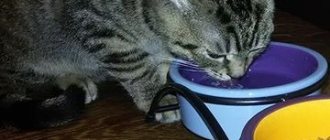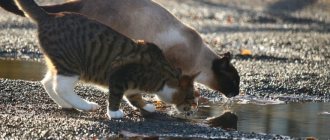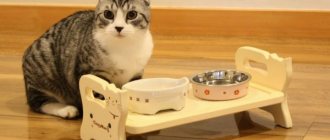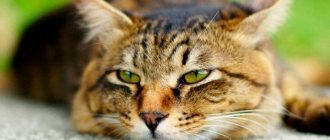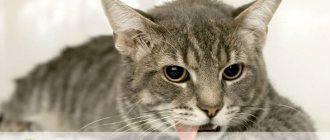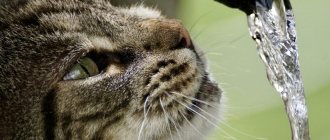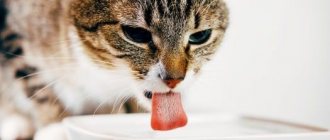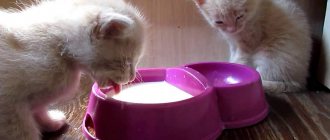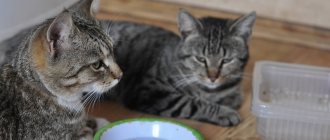10049Administration
3
Without water, warm-blooded animals have no life. Why doesn't the cat drink water? The reasons can be varied: health status, personality traits, diet, illness. This animal behavior cannot be ignored. Before taking any measures, the owner must understand the reason why the cat refuses or drinks little water. It is necessary to analyze her behavior, find out how much water she should drink and how much she actually drinks.
How much water should a cat drink per day?
The average moisture requirement of mammals is about 5% of their live weight. This includes drinking water and taken with food. If there is neither one nor the other, body reserves are consumed: with the oxidation of 100 g of fat, an average of 106 g of water is formed. In hot weather the animal drinks more, in cool weather less.
If your cat is sick, water intake may decrease or increase. Therefore, you should not panic. If the cat does not lap up the water, then perhaps she is getting enough moisture from the food.
Fluid norm for caudates
Only a small number of owners know the daily fluid intake for their pet. Despite this, this indicator is very important and is calculated individually based on a number of criteria.
Volume by mass and activity
On average, the recommended volume is 20-40 ml per 1 kg of weight for adult animals (that is, a 5-kilogram cat will drink about 150 ml, that is, half a glass). For kittens, these numbers increase 2-3 times.
In addition to age and body weight, activity level affects the final value. The norm of mustachioed couch potatoes is lower than that of energetic lovers of regular walks on the street and frequent runs around the house.
Exceeding the norm is permissible within 15-20% of the total volume. If your pet drinks more, there is every reason to suspect something is wrong.
How to determine how much water your pet drinks
The easiest way is to use a measuring cup. Fill it to the full mark and pour the contents into a bowl. At the end of the day, pour the rest back into the glass and compare it with what you had. The resulting difference is the desired value.
If there are several cats, they will have to be temporarily isolated from each other. Otherwise, the experiment will not be indicative. To increase reliability, take several measurements on different days and calculate the arithmetic average.
Reasons why a cat doesn't drink water
All the reasons why a cat does not lap from a bowl are divided into physiological and pathological.
Physiological reasons
The cat does not lap from the bowl for the following reasons:
- Eating natural food or wet canned food. In the wild, there is enough water in the body of a mouse or bird. In the savannah, during the dry season, predators eat meat that contains enough moisture, and if hunting does not bring luck. They use up their own fat reserves.
- The bowl of water smells unpleasant. Instinct does not allow a cat to drink bad water. If the drinker is located next to a tray or feeder, it takes on the smell of excrement or fermented food. In the wild, it is not dirty water that poses a danger to a cat, but microscopic algae that multiply in it and release algatoxins.
- The cat doesn't like the bowl. Metal utensils rattle, plastic utensils absorb odors. Therefore, it is necessary to use ceramic or glass bowls.
Be sure to read:
What to do if pus comes out of your cat’s nose, what could it be, should you be afraid?
Pathological causes
Diseases that cause vomiting, swelling, inflammation of the mouth, paralysis, are accompanied by a refusal to drink. The cat doesn't drink not because he doesn't want to, but because he can't.
The gag reflex applies to everything that enters the stomach: food and water. This condition is called hydrophobia and hydrophobia. Associations with rabies should not be made.
There are many pathological conditions in which a cat refuses to drink. The most dangerous are panleukopenia or calcivirosis. But such diseases are typical for unvaccinated kittens and are distinguished by many other pathological symptoms.
How to help your pet
The best help for your pet is to see a doctor. An exception may be situations when you are absolutely sure that such a condition is caused by stress. For example, a recent move to a new place of residence or the arrival of a new pet or family member. But even here your cat needs help. There are special medications that will help the animal calm down faster and enter the usual rhythm of life (for example, Kot Bayun infusion, collar or Feliway spray).
Feliway is a specially developed pheromone for cats that helps normalize the pet’s behavior in a stressful situation.
Before visiting the veterinarian
Before visiting the veterinarian, the owner can independently take measures to somehow alleviate the pet’s condition:
- Ensure peace and quiet, remove light irritants (dark windows).
- If possible, isolate from other pets (if there are any in the house) in case of an infectious disease.
- Place the pet on a clean bedding, not too soft, but comfortable.
- Place clean water and some of your favorite food next to your pet.
- You can force the cat to drink from a syringe without a needle (2-3 ml every half hour). This must be done if your pet has diarrhea or vomiting, or if the sick person is a kitten.
Drinking from a syringe is a necessary measure to prevent dehydration.
- If there is grass specially grown for your pet, offer it.
You cannot give any medications on your own without the advice of a veterinarian. They can smooth out the symptoms, and it will be more difficult for the doctor to understand the true cause of the cat’s ill health.
You can call your veterinarian by phone and get advice . He will not make a diagnosis over the phone, but he will be able to give some professional recommendations that can help the animal before arriving at the clinic.
I always have a piece of paper pinned with a magnet on my refrigerator with the veterinarian’s number (it’s also written into my phone’s contact book). I usually call to find out a convenient time to accept my pets (so as not to sit in line later). But one day I needed a consultation when the cat was vomiting (she was poisoned by something, as it turned out later, but we did not identify the exact source, because she was walking in the yard and could have eaten anything). The clinic was no longer open (it was evening), and over the phone the doctor advised me to feed the cat Enterosgel and forcefully give her water. This way we were able to hold out until the morning, when the cat was able to receive help at the clinic (including putting on an IV).
After receiving doctor's orders
After the veterinarian has made a diagnosis and prescribed treatment, you should strictly follow all his recommendations. Do not hesitate to clarify all the details regarding taking medications.
Never stop treating your pet before the time prescribed by your doctor, even if it seems to you that he has completely recovered. Infectious diseases require a full course of therapy.
Perhaps the doctor will advise changing the diet, making it more gentle on the pet’s gastrointestinal tract. Special lines of well-known brands of cat food may be suitable, for example:
- Gastro Intestinal from Royal Canin;
Royal Canin Gastro Intestinal - diet for cats with digestive disorders
- Vet Life Cat Gastrointestinal from Farmina;
- PRO PLAN Veterinary Diets EN Gastrointestinal;
- Hill's Prescription Diet Feline i/d.
Additional recommendations
Following these recommendations will help your cat recover faster:
- A calm environment will help your cat get out of stress. You should not force your pet into games and communication.
- If your pet refuses the new diet, go back to the old one. If this is not possible, look for other cat food options (some animals refuse certain brands, so trial and error is the only way to find the right food).
- Ecto- and endoparasites are destroyed using special preparations. There is no need to use them before visiting a doctor, but in the future it is always better to use them for prevention.
- Inflamed gums can be treated with a solution of chlorhexidine or manganese (faint pink). This procedure is carried out twice a day. A piece of gauze is soaked in a medicinal solution and gently pressed onto problem areas of the oral cavity without applying pressure. Depending on the affected area, you can also use cotton swabs, precisely treating the desired areas.
The cat does not drink water, what should I do?
If the cat stops drinking from the bowl, it is necessary to assess his condition and analyze his diet. If the cat is given mushy natural food or wet canned food, enough moisture is supplied. However, some owners believe that the cat must drink and to do this they open the water tap or purchase a drinking fountain. Other felinologists consider tap water unsuitable for pets and purchase bottled water.
If the cat does not lap up water, then it is necessary to monitor its behavior. When a pet is depressed, its eyes are sunken, its fur is disheveled, its skin is flabby, it is necessary to force it to drink. You can draw water into a syringe without a needle and pour it into the mouth drop by drop. The animal may not like it.
Then they resort to an alternative option: saline or Ringer-Locke solution is injected under the skin. The latter remedy is preferable because it contains Potassium, Sodium and Calcium chlorides in the same proportion as blood serum. Glucose binds toxic substances. converts them into safe compounds that are eliminated in the urine.
Up to 150 ml of liquid can be administered per day. After the injection, bulges are formed, which decrease before the eyes. When the cat begins to lap on its own, parenteral administration of the electrolyte solution is stopped. If the animal's general condition does not improve, seek veterinary help.
Be sure to read:
The cat drinks a lot of water: reasons, what to do if the animal is losing weight, how to help
When to go to the vet
- Dry and warm nose. In a healthy animal it is cold and damp.
- Body temperature is above 37-38. It is a sign of infection in the body.
- Diarrhea and vomiting, like fever, are a symptom of infection.
- Deterioration of condition.
Cat refuses water after sterilization
After the operation, the animal recovers from anesthesia and does not eat or drink anything for the first day. On the second day, they begin to feed the pet a little. To prevent the cat from straining and the stitches from coming apart, they give watery food: it is more profitable to take dry food for sterilized cats and dilute it to a liquid state.
You will have to forget about natural nutrition, otherwise the cat will be at risk for obesity and urolithiasis. In this state, the pet will not lap until it is switched to a dry type of food.
Hello saucer!
A small kitten can be compared to a human child, although this comparison is not very correct. But why is such an allegory given? We gradually accustom our children to other foods, but at the same time he continues to eat mother’s milk or special formulas. You should also behave with small kittens. But if there is no cat, and the baby is still small, not even 3 weeks old, then you will need to feed the kitten milk from a pipette or even from a bottle.
Features of nutrition during the transition period
It is very important to introduce any complementary foods gradually. First, make a simple liquid semolina porridge with diluted milk; no sugar should be added.
After the kittens' stool has returned to normal, you can make liquid milk porridge from rice, rolled oats and buckwheat. In parallel with such food, you can also give low-fat cottage cheese. We must remember that everything that kittens eat will not be eaten right away, so you need to put very little food on the plate.
To eat, kittens can approach the bowl very often during the day, but the frequency should not exceed 6 times. Closer to the age of two months, babies need to be taught to eat more solid foods: boiled meat and fish, sometimes you can give them fresh, but be sure to make sure that they don’t get large bones. The pieces of food should be small; sometimes you can mix pieces of fish with any porridge cooked in water. It is best to use ready-made canned food for young children, but you need to carefully monitor them when they begin to eat such food.
How to train to a bowl?
Now we come to the most important question: when and how to accustom a kitten to a saucer and how long this procedure will take. As mentioned earlier, kittens begin to be interested in the saucer at three weeks of age, or rather, they show curiosity about the food of adult cats. Therefore, this particular age is considered one of the best for teaching a baby to eat from a plate.
At first, the baby will constantly snort and sneeze with milk bubbles. This is due to the fact that he is just beginning to comprehend the science of lapping, because quite recently he only sucked his mother’s milk. You can also sometimes see him reaching directly into the bowl with his paws; this must be stopped immediately.
To do this, you need to take it out of there, wipe its paws with a napkin and place it near the bowl. The next time he gets ready to climb into the saucer again, you need to hold him back. This way you can teach the kitten that limbs should not be in the food.
What happens if a cat doesn’t drink water for a long time?
If a sick cat does not drink, a condition called dehydration or dehydration will occur. The load on the heart will increase, which will begin to pump viscous blood.
Be sure to read:
A cat sneezes: causes, symptoms, what to do, treatment methods, what should alert you
The conditions for the enzymes to work will be disrupted. The kidneys will stop filtering toxic substances. Conditions will arise for the formation of blood clots and blockage of blood vessels.
The following pathological symptoms are characteristic of dehydration:
- depressed state;
- the eyes are sunken;
- dry mucous membranes;
- When squeezed, the skin fold straightens out slowly.
Dehydration threatens the animal's life.
